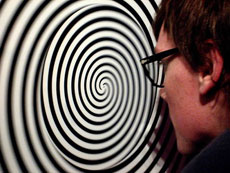 Self hypnosis, once learned, is a powerful skill which can last a lifetime. While there are numerous books, tapes and videos on the subject, one-on-one teaching from a qualified hypnotherapist is likely to produce the most effective results.
Self hypnosis, once learned, is a powerful skill which can last a lifetime. While there are numerous books, tapes and videos on the subject, one-on-one teaching from a qualified hypnotherapist is likely to produce the most effective results.
Hypnosis has been described as: a particular altered state of selective hypersuggestability brought about in an individual by the use of a combination of relaxation, fixation of attention, and suggestion. The techniques can be learned and self-applied to meet virtually any life need or purpose.
There are many levels of relaxation. Full consciousness involves normal intellectual activities of the conscious mind, and normal motor functions. Light relaxation may be recognized by slower breathing and pulse, daydreaming, imagined activity and dialogue etc. Moderate levels of relaxation are characterized by closed eyes, general loss of awareness of surroundings with increased receptivity of the senses and intensified imagery.
Deep levels of relaxation will reduce energy output and activity. Limpness or stiffness of appendages may be experienced together with heightened function of the creative process. Attention will narrow further and suggestibility will increase. Certain illusions of the senses may be noted.
Below these levels comes sleep, with suspension of voluntary movement and ahsence of conscious thought.
Uses of self-hypnosis include self-anaesthesia (controlling pain in dentistry), reducing insomnia, control of some organic functions (blood flow and pressure), some regression, increased abilities in concentration, learning and memory.


